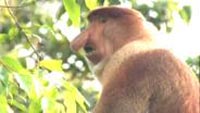First video of ‘remasticating’ proboscis monkeys

‘remasticating’ proboscis monkey<br>
For Marcus Clauss, co-author of this Japanese study, these observations were sensational. He has been researching herbivores with a foregut-fermenting digestive system at the University of Zurich for many years; proboscis monkeys belong to this group of ‘foregut fermenters’, along with hippopotamuses, sloths, kangaroos and cows.
Unlike herbivores such as horses, rhinoceroses, rabbits and many other species of monkey, foregut fermenters have trouble digesting plant fiber in the colon: Their digestive system can’t cope if too much food is ingested as the digesta passes through the foregut too quickly. In other words, they’re condemned to cautious eating. Colon fermenters don’t have that problem, however. These include species with a large food intake such as elephants or a low food intake like koala bears.
According to Clauss, only ruminants – namely cows, buffaloes, deer, antelope, giraffes and camels – have found a solution to the foregut problem. As they reduce the size of the digesta intensively, they can afford to ingest more food. And the proboscis monkey observations seem to support precisely this theory. They reveal that on the whole the monkeys eat longer and therefore presumably more on days when they display ruminant-like behavior than on other days.
So far, this behavior has only been observed in proboscis monkeys from a particular region in Malaysia. Whether this is a regional tradition or all proboscis monkeys display this behavior and it has just gone unnoticed thus far remains unclear.
References:
Ikki Matsuda, Tadahiro Murai, Marcus Clauss, Tomomi Yamada, Augustine Tuuga, Henry Bernardand Seigo Higashi: Regurgitation and remastication in the foregut-fermenting proboscis monkey (Nasalis larvatus), in: Biology Letters, doi:10.1098/rsbl.2011.0197
Contacts:
Dr. Marcus Clauss
University of Zurich, Vetsuisse Faculty
Tel. ++41 44 635 83 76
E-Mail: mclauss@vetclinics.uzh.ch
Media Contact
More Information:
http://www.mediadesk.uzh.chAll latest news from the category: Life Sciences and Chemistry
Articles and reports from the Life Sciences and chemistry area deal with applied and basic research into modern biology, chemistry and human medicine.
Valuable information can be found on a range of life sciences fields including bacteriology, biochemistry, bionics, bioinformatics, biophysics, biotechnology, genetics, geobotany, human biology, marine biology, microbiology, molecular biology, cellular biology, zoology, bioinorganic chemistry, microchemistry and environmental chemistry.
Newest articles

A universal framework for spatial biology
SpatialData is a freely accessible tool to unify and integrate data from different omics technologies accounting for spatial information, which can provide holistic insights into health and disease. Biological processes…

How complex biological processes arise
A $20 million grant from the U.S. National Science Foundation (NSF) will support the establishment and operation of the National Synthesis Center for Emergence in the Molecular and Cellular Sciences (NCEMS) at…

Airborne single-photon lidar system achieves high-resolution 3D imaging
Compact, low-power system opens doors for photon-efficient drone and satellite-based environmental monitoring and mapping. Researchers have developed a compact and lightweight single-photon airborne lidar system that can acquire high-resolution 3D…





















